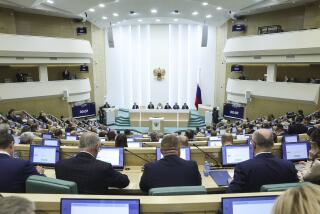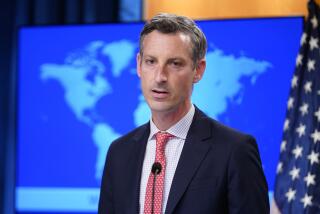U.S., Soviets to Hold Joint Nuclear Tests
- Share via
GENEVA — The United States and the Soviet Union have agreed to carry out several joint nuclear test explosions next year to calibrate equipment to help verify any future pacts on atomic blasts, a U.S. official said today.
The tests would be the first such joint explosions since the dawn of the Nuclear Age in 1945, and the announcement came less than three weeks before the superpowers were due to sign an accord in Washington scrapping medium-range missiles.
Robert Barker, head of the U.S. team negotiating with the Soviet Union on limiting nuclear tests, told a news conference that each side will visit the other’s atomic test sites in January, 1988, to familiarize itself with the areas.
Calibration Purposes
The joint test explosions would come five or six months later and would be aimed at calibrating monitoring equipment to help verify any future accords on nuclear testing, he said.
Barker was speaking after the close today of two weeks of talks with a Soviet team headed by Igor Palenykh.
In the initial joint tests, the Americans will go to the Soviet Semipalatinsk test site in Central Asia and show their preferred method of monitoring the size of atomic blasts, called CORRTEX, Barker said.
The Soviets, during joint atomic experiments at the U.S. nuclear test site in Nevada, will try to prove the accuracy of their preferred monitoring method, which counts seismic units such as those used in monitoring earthquakes.
Different Distances
One essential difference is that in the American method an electrical cable must be placed within 10 or 15 yards of the blast. In the Soviet method, the earth’s tremors are monitored from many miles away.
Barker said the initial agreement is for one or two atomic blasts at each site. The final decision will be taken when the negotiators meet to design the joint nuclear test experiments.
“Only when we’ve sat down to design the experiments will we know if one or two is enough,” he said.
Barker said a second round of talks will begin shortly after the exchange visits to the superpower test sites.
Decision on Talks
The round that ended today followed a decision in mid-September by Secretary of State George P. Shultz and Soviet Foreign Minister Eduard A. Shevardnadze to resume nuclear testing talks for the first time in seven years.
More to Read
Sign up for Essential California
The most important California stories and recommendations in your inbox every morning.
You may occasionally receive promotional content from the Los Angeles Times.










